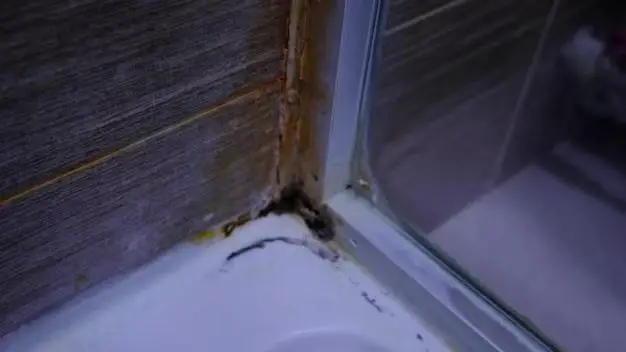Having mold on your bathroom ceiling is unfortunately quite common, but that does not mean it is normal or healthy. Mold grows in damp environments and thrives in the warm, humid conditions often found in bathrooms. While a small amount of mold is to be expected, a large mold patch or recurring mold suggests there is an underlying moisture issue that needs to be addressed.
Page Contents
What Causes Mold on Bathroom Ceilings?
There are a few common causes of mold growth on bathroom ceilings:
Steam and condensation
Steam from hot showers can rise and condense on cooler ceiling surfaces, allowing moisture to accumulate. Poor ventilation means the moisture lingers, creating an environment for mold.
Plumbing leaks
Leaks from faulty plumbing above the ceiling can saturate drywall or plaster and cause mold. This includes leaks from the shower, tub, toilet, sink plumbing or even HVAC condensate drain lines.
Roof leaks
Leaks from the roof can drip down into the ceiling cavity and lead to mold growth. This often occurs around vents, skylights or chimneys that are not properly sealed and flashing is damaged.
Flooding
Major flooding from rainstorms, plumbing failures or overflowing tubs/sinks can soak ceiling drywall and plaster, resulting in mold.
Is Mold Dangerous?
In addition to being unsightly, mold growth can pose health risks for your family. Mold spores and particles can irritate eyes, skin, nose, throat and lungs, causing symptoms like:
- Congestion
- Coughing
- Wheezing
- Chest tightness
- Skin rashes
- Itchy eyes
People with allergies and asthma may be more severely affected. Prolonged exposure to high levels of mold has also been linked to upper respiratory tract problems.
Certain types of mold produce mycotoxins that can make you sick. Mycotoxins are released when mold spores die and the mold starts to decay. Even dead mold can still lead to health issues.
Should I Be Concerned About a Small Amount of Mold?
A small patch of mold on your bathroom ceiling may not be cause for alarm. Limiting moisture and thoroughly cleaning and drying the area may take care of the problem.
However, you should be concerned if you notice any of the following:
- Mold patch larger than 10 square feet
- Visible mold growth that keeps returning
- Musty odor that persists after cleaning
- Signs of water damage or damp drywall/plaster
- Plumbing leaks above the ceiling
- Health symptoms that occur when in the bathroom
Larger areas of mold growth suggest an underlying moisture issue that will continue to promote mold spread if left unaddressed. Recurring mold, odors and health effects indicate a potentially serious problem.
How to Get Rid of Mold on the Ceiling
Since mold requires moisture to grow, the key is to locate and fix any water leaks or humidity issues. Mold removal will be temporary if the damp conditions remain. Here are some tips for mold remediation:
Fix plumbing leaks
Repair any leaky pipes, seals, valves or fixtures both above and below the ceiling. Prevent shower spray from escaping and impacting the ceiling. Ensure proper slope for drainage.
Improve ventilation
Increase air circulation with a strong exhaust fan. Keep it running for at least 30 minutes after bathing or showering. Open windows whenever possible.
Clean mold off surfaces
Mix a non-ammonia soap or detergent solution in water, then scrub the mold off surfaces. Dry the area completely.
Disinfect with bleach
Wipe down the area with a 10% bleach solution after mold is removed to kill any remaining spores.
Replace porous materials
Heavily mold-damaged drywall, plaster or insulation may need replacement. Use mold-resistant materials.
Seal leaks
Fix roof and window leaks to prevent moisture entering from outside. Look for gaps around vents, ductwork and piping penetrating the ceiling.
Consider professional help
For large areas of mold growth, persistent mold issues or if you have health concerns, contact a mold remediation specialist.
How to Prevent Mold on Bathroom Ceilings
Prevention is the best way to avoid bathroom ceiling mold. Try these proactive measures:
Install exhaust fan
A high-powered, ENERGY STAR rated exhaust fan is key. Run it during and after showering or baths.
Open windows
Cross-ventilation allows fresh air in and moist air out. Open windows whenever possible.
Use mold-resistant paint
Paint bathroom ceilings with mildew-resistant paint. Avoid flat paints which absorb moisture.
Insulate cold water pipes
Prevent sweating pipes that drip condensation. Insulate exposed cold water supply lines.
Clean and disinfect regularly
Regularly clean your bathroom with an antimicrobial cleaner and bleach solution. Keep surfaces free of dust buildup.
Fix drips and leaks promptly
Don’t delay on plumbing repairs. Inspect ceiling after baths and showers for any moisture.
Dehumidify the air
Use a dehumidifier to maintain humidity under 50%. Avoid overfilling humidifiers.
Increase airflow in attic
Ensure bathroom exhaust fan ductwork extends fully into the attic. Insulate ducts to reduce condensation.
When to Call a Professional
You should call in a professional mold remediation contractor if:
- Mold patches are larger than 10 square feet
- Mold keeps recurring and spreading
- You have a persistent musty odor
- You see signs of extensive water damage
- Mold is entering from an inaccessible area like inside walls or the HVAC system
- You have health issues when exposed to the mold
- You are unable to identify or resolve the moisture source
Professionals have the expertise, equipment and products to thoroughly dry out affected areas, kill mold, prevent recurrence and make structural repairs. They can also test to identify specific mold types and check for hidden mold growth.
Conclusion
While having a small amount of mold on your bathroom ceiling is fairly common, recurring mold growth or large areas of mold indicate a moisture issue that needs to be corrected. Eliminating excess humidity and fixing leaks are key to getting rid of mold for good. With persistent mold problems or large patches, contact a mold remediation professional promptly to assess your situation and make it safe and healthy again.

